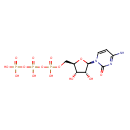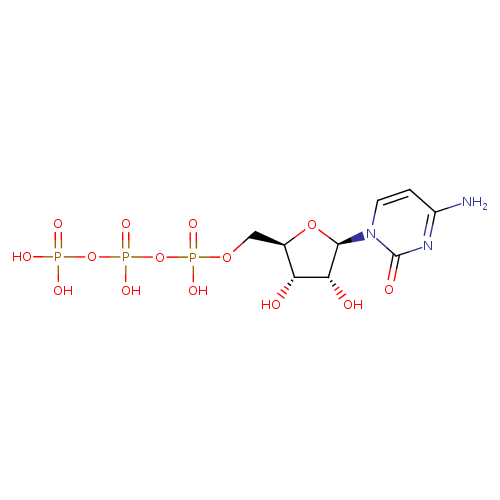|
Record Information |
|---|
| Version |
1.0 |
|---|
| Update Date |
1/22/2018 11:54:54 AM |
|---|
|
Metabolite ID | PAMDB110525 |
|---|
|
Identification |
|---|
| Name: |
CTP |
|---|
| Description: | A nucleoside triphosphate(4−) obtained by global deprotonation of the triphosphate OH groups of CTP; major species present at pH 7.3. |
|---|
|
Structure |
|
|---|
| Synonyms: | -
cytidine-triphosphate
-
cytidine-5'-triphosphate
|
|---|
|
Chemical Formula: |
C9H12N3O14P3
|
|---|
| Average Molecular Weight: |
479.13 |
|---|
| Monoisotopic Molecular
Weight: |
482.9845117686 |
|---|
| InChI Key: |
PCDQPRRSZKQHHS-XVFCMESISA-J |
|---|
| InChI: |
InChI=1S/C9H16N3O14P3/c10-5-1-2-12(9(15)11-5)8-7(14)6(13)4(24-8)3-23-28(19,20)26-29(21,22)25-27(16,17)18/h1-2,4,6-8,13-14H,3H2,(H,19,20)(H,21,22)(H2,10,11,15)(H2,16,17,18)/p-4/t4-,6-,7-,8-/m1/s1 |
|---|
| CAS
number: |
65-47-4 |
|---|
| IUPAC Name: | cytidine 5'-triphosphate(4−) |
|---|
|
Traditional IUPAC Name: |
CTP |
|---|
| SMILES: | C(OP(=O)([O-])OP(=O)([O-])OP(=O)([O-])[O-])C1(OC(C(O)C(O)1)N2(C=CC(N)=NC(=O)2)) |
|---|
|
Chemical Taxonomy |
|---|
|
Taxonomy Description | This compound belongs to the class of chemical entities known as pentose phosphates. These are carbohydrate derivatives containing a pentose substituted by one or more phosphate groups. |
|---|
|
Kingdom |
Chemical entities |
|---|
| Super Class | Organic compounds |
|---|
|
Class |
Organic oxygen compounds |
|---|
| Sub Class | Organooxygen compounds |
|---|
|
Direct Parent |
Pentose phosphates |
|---|
| Alternative Parents |
|
|---|
| Substituents |
- Pentose phosphate
- Pentose-5-phosphate
- Glycosyl compound
- N-glycosyl compound
- Monosaccharide phosphate
- Hydroxypyrimidine
- Monoalkyl phosphate
- Hydropyrimidine
- Organic phosphoric acid derivative
- Phosphoric acid ester
- Pyrimidine
- Alkyl phosphate
- Heteroaromatic compound
- Oxolane
- 1,2-diol
- Secondary alcohol
- Oxacycle
- Organoheterocyclic compound
- Azacycle
- Organic nitrogen compound
- Hydrocarbon derivative
- Organonitrogen compound
- Alcohol
- Organic oxide
- Organopnictogen compound
- Aromatic heteromonocyclic compound
|
|---|
| Molecular Framework |
Aromatic heteromonocyclic compounds |
|---|
| External Descriptors |
|
|---|
|
Physical Properties |
|---|
| State: |
Solid |
|---|
| Charge: | -4 |
|---|
|
Melting point: |
215 - 218 °C |
|---|
| Experimental Properties: |
| Property | Value | Reference |
|---|
| Melting Point | 215 - 218 °C | Not Available | | Boiling Point | Not Available | Not Available | | Water Solubility | Not Available | Not Available | | LogP | Not Available | Not Available |
|
|---|
| Predicted Properties |
|
|---|
|
Biological Properties |
|---|
| Cellular Locations: |
Not Available |
|---|
| Reactions: | |
|---|
|
Pathways: |
|
|---|
|
Spectra |
|---|
| Spectra: |
| Spectrum Type | Description | Splash Key | |
|---|
| LC-MS/MS | LC-MS/MS Spectrum - Quattro_QQQ 10V, Positive (Annotated) | splash10-00b9-5685900000-b067d3b0af4c194d5224 | View in MoNA |
|---|
| LC-MS/MS | LC-MS/MS Spectrum - Quattro_QQQ 25V, Positive (Annotated) | splash10-0a4i-0309200000-33e695326ec0d28103b4 | View in MoNA |
|---|
| LC-MS/MS | LC-MS/MS Spectrum - Quattro_QQQ 40V, Positive (Annotated) | splash10-057j-1926700000-417741bbe965170223c0 | View in MoNA |
|---|
| Predicted LC-MS/MS | Predicted LC-MS/MS Spectrum - 10V, Positive | Not Available |
|---|
| Predicted LC-MS/MS | Predicted LC-MS/MS Spectrum - 20V, Positive | Not Available |
|---|
| Predicted LC-MS/MS | Predicted LC-MS/MS Spectrum - 40V, Positive | Not Available |
|---|
| Predicted LC-MS/MS | Predicted LC-MS/MS Spectrum - 10V, Negative | Not Available |
|---|
| Predicted LC-MS/MS | Predicted LC-MS/MS Spectrum - 20V, Negative | Not Available |
|---|
| Predicted LC-MS/MS | Predicted LC-MS/MS Spectrum - 40V, Negative | Not Available |
|---|
| 1D NMR | 1H NMR Spectrum | Not Available |
|---|
| 1D NMR | 1H NMR Spectrum | Not Available |
|---|
| 1D NMR | 13C NMR Spectrum | Not Available |
|---|
| 2D NMR | [1H,1H] 2D NMR Spectrum | Not Available |
|---|
| 2D NMR | [1H,13C] 2D NMR Spectrum | Not Available |
|---|
|
|---|
|
References |
|---|
| References: |
- Watanabe T, Oguchi K, Ebara S, Fukui T: Measurement of 3-hydroxyisovaleric acid in urine of biotin-deficient infants and mice by HPLC. J Nutr. 2005 Mar;135(3):615-8. [15735103 ]
- Kondo T, Ohtsuka Y, Shimada M, Kawakami Y, Hiyoshi Y, Tsuji Y, Fujii H, Miwa S: Erythrocyte-oxidized glutathione transport in pyrimidine 5'-nucleotidase deficiency. Am J Hematol. 1987 Sep;26(1):37-45. [2888306 ]
- Kallander CF, Gronowitz JS, Olding-Stenkvist E: Varicella zoster virus deoxythymidine kinase is present in serum before the onset of varicella. Scand J Infect Dis. 1989;21(3):255-7. [2547243 ]
- de Korte D, Haverkort WA, van Gennip AH, Roos D: Nucleotide profiles of normal human blood cells determined by high-performance liquid chromatography. Anal Biochem. 1985 May 15;147(1):197-209. [4025817 ]
- Verschuur AC, Brinkman J, Van Gennip AH, Leen R, Vet RJ, Evers LM, Voute PA, Van Kuilenburg AB: Cyclopentenyl cytosine induces apoptosis and increases cytarabine-induced apoptosis in a T-lymphoblastic leukemic cell-line. Leuk Res. 2001 Oct;25(10):891-900. [11532523 ]
- Cornell RB, Northwood IC: Regulation of CTP:phosphocholine cytidylyltransferase by amphitropism and relocalization. Trends Biochem Sci. 2000 Sep;25(9):441-7. [10973058 ]
|
|---|
| Synthesis Reference: |
Simon, Ethan S.; Bednarski, Mark D.; Whitesides, George M. Synthesis of CMP-NeuAc from N-acetylglucosamine: generation of CTP from CMP using adenylate kinase. Journal of the American Chemical Society (1988), 110(21), 7159-63. |
|---|
| Material Safety Data Sheet (MSDS) |
Download (PDF) |
|---|
|
Links |
|---|
| External Links: |
|
|---|


